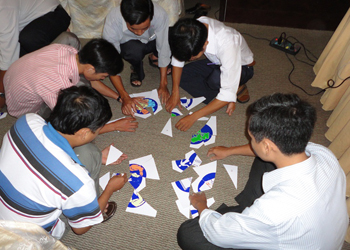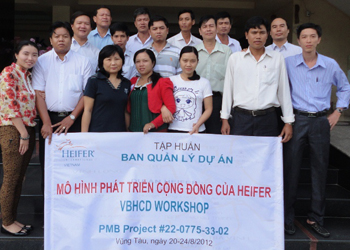Information and photos by Phan Nguyen Khanh Trang | Program Officer | Heifer Vietnam
Translated by Nguyen Xuan Quyen | CNO | Heifer Vietnam
 Fifteen project leaders participated in a 1 ½-day training to improve their group’s project management capacity, organized by Heifer Vietnam (HVN) in partnership with the Project Management Board (PMB) of Tra Vinh province. This Values-Based Holistic Community Development (VBHCD) training, held August 20–24, 2012, is part of the Improving the Disadvantageous Farm Households’ Capacity in Tra Vinh Province Through VBHCD project.
Fifteen project leaders participated in a 1 ½-day training to improve their group’s project management capacity, organized by Heifer Vietnam (HVN) in partnership with the Project Management Board (PMB) of Tra Vinh province. This Values-Based Holistic Community Development (VBHCD) training, held August 20–24, 2012, is part of the Improving the Disadvantageous Farm Households’ Capacity in Tra Vinh Province Through VBHCD project.
The training participants included project assistants, project accountants, a Community Animal Healthcare Worker (CAHW), Self-Help Group (SHG) treasurers, community facilitators and PMB members at the communal level. They exchanged their knowledge and experience with the VBHCD model, Heifer’s 12 Cornerstones for Just and Sustainable Development, Participatory Self-Review and Planning Process (PSRP), Personal Leadership Development (PLD), and Visioning. They raised challenges and difficulties they have faced with project management and worked together to come up with solutions.
Games and visual aids used to illustrate the 12 Cornerstones helped make participants feel interested and absorb the lesson effectively. They worked together on activities relating to the Cornerstones for farmers and others engaging in the project, as well as simple but effective training methodologies for their target communities. Mrs. Hang, a community facilitator of a project in Tra Vinh, said, “Though I have attended many trainings on the 12 Cornerstones, I still accumulate a lot of useful experiences and new training methodologies for myself each time.”
 Trainees focused on how to apply this approach in their own management methods and to guide and support their SHGs in conducting PSRPs for improved effectiveness. They were divided into small groups to practice conducting a PSRP in an SHG meeting by ballot, as well as publicly, and they raised challenges they have encountered in project management. Based on the Cornerstones, the trainees used “I will” statements to make action plans after a self-assessment with PSRP. Mr. Tat, a project accountant, said he used to have difficulty conducting PSRPs, but after this training that included detailed theory and practice, he now understands it more clearly. “In my opinion, this is a useful and effective approach for each project member to be able to assess themselves and their activities for well-organized action plans.”
Trainees focused on how to apply this approach in their own management methods and to guide and support their SHGs in conducting PSRPs for improved effectiveness. They were divided into small groups to practice conducting a PSRP in an SHG meeting by ballot, as well as publicly, and they raised challenges they have encountered in project management. Based on the Cornerstones, the trainees used “I will” statements to make action plans after a self-assessment with PSRP. Mr. Tat, a project accountant, said he used to have difficulty conducting PSRPs, but after this training that included detailed theory and practice, he now understands it more clearly. “In my opinion, this is a useful and effective approach for each project member to be able to assess themselves and their activities for well-organized action plans.”
Other topics interested the trainees, as well. Mr. Liem, a member of a PMB at the communal level, said, “The training provides many useful and interesting lessons and knowledge. I was personally interested in Personal Leadership Development and group visioning because it allowed me to see my strengths to realize my work and my personal goals in the future.”
Indeed, through PLD, the participants see their value and their roles in both the project and the community. They are indispensable components of a strong and complete structure. Moreover, they are able to see their efforts and their "nothing is impossible" achievements by drawing pictures of their journey from the past to present and heading into the future. They analyze the challenges and weakness of the past drawings and withdraw their experiences for the present and future. The present drawing shows them their improvements and the future motivates them to work hard to hit their goals for themselves, their families and their communities.